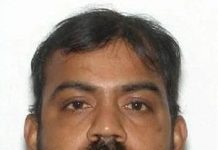
Photo: Toronto Police Service
ARRESTED on January 18, McArthur has been charged with six counts of First Degree murder in relation to the deaths of Selim Esen, Andrew Kinsman, Soroush Mahmaudi, Dean Lisowick, Majeed Kayhan and Skanda Navaratnam.
At a news conference at police headquarters on Monday (March 5), investigators released a photograph of an individual they believe is an unidentified victim of McArthur.
“We have utilized numerous investigative techniques to identify this individual and have been unsuccessful,” said D/Sgt. Hank Idsinga. “We have also shown the picture to numerous contacts within the community and have been unsuccessful. I do not want to release this picture and am doing so as a last resort.”
He is asking anyone who recognizes the picture to contact police as soon as possible at 416-808-2021.
“We need to put a name to this face and bring closure to this man’s loved ones,” said Idsinga.
One of the focuses of the investigation has been on human remains found within planters at 53 Mallory Crescent.
“As I have stated before, these remains are of individuals who have been dismembered,” said Idsinga. “They are in various stages of decomposition. Doctors from Ontario Forensic Pathology Services have been doing some very difficult and time-consuming work in attempting to reconstruct these remains and identify them.”
Investigators have recovered the remains of at least seven individuals from the planters seized at Mallory Crescent. Tests are ongoing in an attempt to continue to identify these victims.
Idsinga said that forensic anthropologist Dr. Kathy Gruspier and Ontario’s Chief Forensic Pathologist Dr. Michael Pollanen have been working tirelessly for weeks to put this very crucial part of the case together.
“This particular case has challenged the Ontario Forensic Pathology Service and we have used a multi-disciplinary approach to try and find the truth behind what’s happened,” Dr. Pollanen said. “We have two major centres of gravity in a case like this. The first is there is an overwhelming humanitarian objective to identify the people who, in his case, have gone missing and have been found dismembered and decomposed in planters’ pots. This humanitarian objective of determining who went missing and identifying their bodies is an important application of forensic science and medicine.
“On the other hand and equally important is the creation of a reliable data set that can be used in the criminal justice process. So, it is these two major objectives which have informed our process. This is through teamwork because we need to utilise many different scientific disciplines – pathology, antrophology, dentistry, fingerprints, all of these different modalities are integrated together to understand what’s happened.”
Pollanen said this is the most unique investigation in the history of his organization.
“It is drawing on the talents and expertise of at least everyone in the organization,” he said. “I am very grateful for the dedication of all of our staff in this case, not only because of the gravity of the situation and the technical difficulties presented with the case, but also with the volume of work. So all of those things are challenging, organizationally and individually.”
By Ron Fanfair, Toronto Police Service











